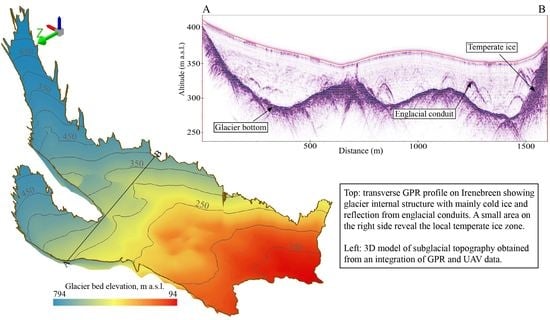UAV and GPR Data Integration in Glacier Geometry Reconstruction: A Case Study from Irenebreen, Svalbard
Abstract
:1. Introduction
2. Study Area
3. Materials and Methods
3.1. GPR Survey
3.2. GNSS
3.3. UAV Survey and Photogrammetric Processing
- Alignment accuracy: high;
- Key point limit: 50,000;
- Tie point limit: 0;
- Reference preselection: source.
- Quality: high;
- Filtering mode: mild;
- Confidence computation: enabled.
3.4. Reconstructing the Geometry of Irenebreen
4. Results
4.1. GPR Signal Propagation Speed
4.2. Ice Thickness, Surface and Subglacial Topography
4.3. Extent and Geometry of Temperate Ice
5. Discussion
5.1. UAV Survey
5.2. GPR Data Processing and Interpretation
5.3. Internal Structure of Irenebreen
6. Conclusions
Author Contributions
Funding
Data Availability Statement
Acknowledgments
Conflicts of Interest
References
- Schuler, T.V.; Kohler, J.; Elagina, N.; Hagen, J.O.M.; Hodson, A.J.; Jania, J.A.; Kääb, A.M.; Luks, B.; Małecki, J.; Moholdt, G.; et al. Reconciling Svalbard Glacier Mass Balance. Front. Earth Sci. 2020, 8, 156. [Google Scholar] [CrossRef]
- Bahr, D.B.; Radić, V. Significant contribution to total mass from very small glaciers. Cryosphere 2012, 6, 763–770. [Google Scholar] [CrossRef] [Green Version]
- Colucci, R.R.; Forte, E.; Boccali, C.; Dossi, M.; Lanza, L.; Pipan, M.; Guglielmin, M. Evaluation of Internal Structure, Volume and Mass of Glacial Bodies by Integrated LiDAR and Ground Penetrating Radar Surveys: The Case Study of Canin Eastern Glacieret (Julian Alps, Italy). Surv. Geophys. 2015, 36, 231–252. [Google Scholar] [CrossRef]
- Navarro, F.J.; Martín-Espanol, A.; Lapazaran, J.J.; Grabiec, M.; Otero, J.; Vasilenko, E.V.; Puczko, D. Ice volume estimates from ground-penetrating radar surveys, wedel Jarlsberg land glaciers, Svalbard. Arc. Antarct. Alp. Res. 2014, 46, 394–406. [Google Scholar] [CrossRef] [Green Version]
- Björnsson, H.; Gjessing, Y.; Hamran, S.E.; Hagen, J.O.; LiestøL, O.; Pálsson, F.; Erlingsson, B. The thermal regime of sub-polar glaciers mapped by multi-frequency radio-echo sounding. J. Glaciol. 1996, 42, 23–32. [Google Scholar] [CrossRef] [Green Version]
- Sevestre, H.; Benn, D.I.; Hulton, N.R.; Bælum, K. Thermal structure of Svalbard glaciers and implications for thermal switch models of glacier surging. J. Geophys. Res. Earth Surf. 2015, 120, 2220–2236. [Google Scholar] [CrossRef] [Green Version]
- Martín-Español, A.; Vasilenko, E.V.; Navarro, F.J.; Otero, J.; Lapazaran, J.J.; Lavrentiev, I.; Macheret, Y.Y.; Machío, F. Radio-echo sounding and ice volume estimates of western Nordenskiöld Land glaciers, Svalbard. Ann. Glaciol. 2013, 54, 211–217. [Google Scholar] [CrossRef]
- Andreassen, L.M.; Moholdt, G.; Kääb, A.; Messerli, A.; Nagy, T.; Winsvold, S.H. Data. In Monitoring Glaciers in Mainland Norway and Svalbard Using Sentinel; Andreassen, L.M., Ed.; Norwegian Water Resources and Energy Directorate (NVE): Oslo, Norway, 2021; pp. 14–27. [Google Scholar]
- Fischer, M.; Huss, M.; Hoelzle, M. Surface elevation and mass changes of all Swiss glaciers 1980–2010. Cryosphere 2015, 9, 525–540. [Google Scholar] [CrossRef] [Green Version]
- Paul, F.; Bolch, T.; Kääb, A.; Nagler, T.; Nuth, C.; Scharrer, K.; Shepherd, A.; Strozzi, T.; Ticconi, F.; Bhambri, R.; et al. The glaciers climate change initiative: Methods for creating glacier area, elevation change and velocity products. Remote Sens. Environ. 2015, 162, 408–426. [Google Scholar] [CrossRef] [Green Version]
- Lamsters, K.; Karušs, J.; Rečs, A.; Bērziņš, D. Detailed subglacial topography and drumlins at the marginal zone of Múlajökull outlet glacier, central Iceland: Evidence from low frequency GPR data. Polar Sci. 2016, 10, 470–475. [Google Scholar] [CrossRef]
- Kodde, M.P.; Pfeifer, N.; Gorte, B.G.H.; Geistd, T.; Höfle, B. Automatic glacier surface analysis from airborne laser scanning. Int. Arch. Photogramm. Remote Sens. 2007, 36, 221–226. [Google Scholar]
- Knoll, C.; Kerschner, H. A glacier inventory for South Tyrol, Italy, based on airborne laser scanner data. Ann. Glaciol. 2009, 53, 46–52. [Google Scholar] [CrossRef] [Green Version]
- Karušs, J.; Lamsters, K.; Sobota, I.; Ješkins, J.; Džeriņš, P.; Hodson, A. Drainage system and thermal structure of a High Arctic polythermal glacier: Waldemarbreen, western Svalbard. J. Glaciol. 2021, 1–14. [Google Scholar] [CrossRef]
- Lamsters, K.; Karušs, J.; Krievāns, M.; Ješkins, J. The thermal structure, subglacial topography and surface structures of the NE outlet of Eyjabakkajökull, east Iceland. Polar Sci. 2020, 100566. [Google Scholar] [CrossRef]
- Lamsters, K.; Karušs, J.; Krievāns, M.; Ješkins, J. High-resolution orthophoto map and digital surface models of the largest Argentine Islands (the Antarctic) from unmanned aerial vehicle photogrammetry. J. Maps 2020, 16, 335–347. [Google Scholar] [CrossRef]
- Lamsters, K.; Karušs, J.; Krievāns, M.; Ješkins, J. High-Resolution Surface and Bed Topography Mapping of Russell Glacier (SW Greenland) Using UAV and GPR. ISPRS Ann. Photogramm. Remote Sens. Spat. Inf. Sci. 2020, 2, 757–763. [Google Scholar] [CrossRef]
- Śledź, S.; Ewertowski, M.; Piekarczyk, J. Applications of unmanned aerial vehicle (UAV) surveys and Structure from Motion photogrammetry in glacial and periglacial geomorphology. Geomorphology 2021, 378, 107620. [Google Scholar] [CrossRef]
- Ewertowski, M.W.; Tomczyk, A.M.; Evans, D.J.A.; Roberts, D.H.; Ewertowski, W. Operational Framework for Rapid, Very-high Resolution Mapping of Glacial Geomorphology Using Low-cost Unmanned Aerial Vehicles and Structure-from-Motion Approach. Remote Sens. 2019, 11, 65. [Google Scholar] [CrossRef] [Green Version]
- Bash, E.A.; Moorman, B.J.; Gunther, A. Detecting Short-Term Surface Melt on an Arctic Glacier Using UAV Surveys. Remote Sens. 2018, 10, 1547. [Google Scholar] [CrossRef] [Green Version]
- Bhardwaj, A.; Sam, L.; Martín-Torres, F.J.; Kumar, R. UAVs as remote sensing platform in glaciology: Present applications and future prospects. Remote Sens. Environ. 2016, 175, 196–204. [Google Scholar] [CrossRef]
- Cao, B.; Guan, W.; Li, K.; Pan, B.; Sun, X. High-Resolution Monitoring of Glacier Mass Balance and Dynamics with Unmanned Aerial Vehicles on the Ningchan No. 1 Glacier in the Qilian Mountains, China. Remote Sens. 2021, 13, 2735. [Google Scholar] [CrossRef]
- Pellikka, P.; Rees, W.G. Remote Sensing of Glaciers. In Techniques for Topographic, Spatial and Thematic Mapping of Glaciers; Taylor & Francis Group: London, UK, 2009; p. 330. [Google Scholar]
- Bogorotsky, V.V.; Bentley, C.R.; Gudmandsen, P.E. Radioglaciology; D. Reidel Publishing Co.: Dordrecht, The Netherlands, 1985; pp. 32–48. [Google Scholar]
- Fischer, A.; Kuhn, M. Ground-penetrating radar measurements of 64 Austrian glaciers between 1995 and 2010. Ann. Glaciol. 2013, 54, 179–188. [Google Scholar] [CrossRef] [Green Version]
- Church, G.; Bauder, A.; Grab, M.; Rabenstein, L.; Singh, S.; Maurer, H. Detecting and characterising an englacial conduit network within a temperate Swiss glacier using active seismic, ground penetrating radar and borehole analysis. Ann. Glaciol. 2019, 60, 193–205. [Google Scholar] [CrossRef] [Green Version]
- Booth, A.; Mercer, A.; Clark, R.; Murray, T.; Jansson, P.; Axtell, C. A comparison of seismic and radar methods to establish the thickness and density of glacier snow cover. Ann. Glaciol. 2013, 54, 73–82. [Google Scholar] [CrossRef] [Green Version]
- Ødegård, R.S.; Hamran, S.E.; Bø, P.H.; Etzelmuller, B.; Vatne, G.; Sollid, J.L. Thermal regime of a valley glacier, Erikbreen, northern Spitsbergen. Polar Res. 1992, 11, 69–79. [Google Scholar] [CrossRef]
- Sobota, I. Physical geography of Kaffiøyra. In Atlas of Changes in the Glaciers of Kaffiøyra (Svalbard, the Arctic); Sobota, I., Ed.; Wydawnictwo Naukowe Uniwersytetu Mikołaja Kopernika: Toruń, Poland, 2021; pp. 51–65. [Google Scholar]
- Sobota, I. Glaciers of Svalbard. In Atlas of Changes in the Glaciers of Kaffiøyra (Svalbard, the Arctic); Sobota, I., Ed.; Wydawnictwo Naukowe Uniwersytetu Mikołaja Kopernika: Toruń, Poland, 2021; pp. 29–47. [Google Scholar]
- Sobota, I. Snow accumulation, melt, mass loss, and the near-surface ice temperature structure of Irenebreen, Svalbard. Polar Sci. 2011, 5, 327–336. [Google Scholar] [CrossRef] [Green Version]
- Wójcik, K.A.; Sobota, I. Spatial and temporal changes in ablation, distribution and evolution of glacial zones on Irenebreen, a small glacier of the High Arctic, Svalbard. Polar Sci. 2020, 23, 100503. [Google Scholar] [CrossRef]
- Sobota, I. Selected problems of snow accumulation on glaciers during long-term studies in north-western Spitsbergen, Svalbard. Geogr. Ann. Ser. A Phys. Geogr. 2017, 99, 177–192. [Google Scholar] [CrossRef]
- Sobota, I.; Weckwerth, P.; Grajewski, T. Rain-On-Snow (ROS) events and their relations to snowpack and ice layer changes on small glaciers in Svalbard, the high Arctic. J. Hydrol. 2020, 590, 125279. [Google Scholar] [CrossRef]
- Sobota, I.; Nowak, M.; Różański, K.M. Changes in glaciers of Kaffiøyra. In Atlas of Changes in the Glaciers of Kaffiøyra (Svalbard, the Arctic); Sobota, I., Ed.; Wydawnictwo Naukowe Uniwersytetu Mikołaja Kopernika: Toruń, Poland, 2021; pp. 109–185. [Google Scholar]
- Sobota, I.; Nowak, M.; Weckwerth, P. Long-term changes of glaciers in north-western Spitsbergen. Glob. Planet. Chang. 2016, 144, 182–197. [Google Scholar] [CrossRef]
- Kejna, M.; Sobota, I. Meteorological conditions on Kaffiøyra (NW Spitsbergen) in 2013–2017 and their connection with atmospheric circulation and sea ice extent. Pol. Polar Res. 2019, 40, 175–204. [Google Scholar]
- Kejna, M.; Sobota, I. Climate of Kaffiøyra. In Atlas of Changes in the Glaciers of Kaffiøyra (Svalbard, the Arctic); Sobota, I., Ed.; Wydawnictwo Naukowe Uniwersytetu Mikołaja Kopernika: Toruń, Poland, 2021; pp. 67–75. [Google Scholar]
- Galley, R.J.; Trachtenberg, M.; Langlois, A.; Barber, D.G.; Shafai, L. Observations of geophysical and dielectric properties and ground penetrating radar signatures for discrimination of snow, sea ice and freshwater ice thickness. Cold Reg. Sci. Technol. 2009, 57, 29–38. [Google Scholar] [CrossRef]
- Grab, M.; Mattea, E.; Bauder, A.; Huss, M.; Rabenstain, L.; Hodel, E.; Linsbauer, A.; Langhammer, L.; Schmid, L.; Church, G.; et al. Ice thickness distribution of all Swiss glaciers based on extended ground-penetrating radar data and glaciological modeling. J. Glaciol. 2021, 67, 1–19. [Google Scholar] [CrossRef]
- Egli, E.E.; Irving, J.; Lane, S.N. Characterization of subglacial marginal channels using 3-D analysis of high-density ground-penetrating radar data. J. Glaciol. 2021, 67, 1–14. [Google Scholar] [CrossRef]
- Forte, E.; Santin, I.; Ponti, S.; Colucci, R.R.; Gutgesell, P.; Guglielmin, M. New insights in glaciers characterization by differential diagnosis integrating GPR and remote sensing techniques: A case study for the Eastern Gran Zebrù glacier (Central Alps). Remote Sens. Environ. 2021, 267, 112715. [Google Scholar] [CrossRef]
- Jol, H. Ground Penetrating Radar Theory and Applications, 1st ed.; Elsevier Science: Amsterdam, The Netherlands, 2009. [Google Scholar]
- Leng, Z.; Al-Qadi, I.L. An innovative method for measuring pavement dielectric constant using the extended CMP method with two air-coupled GPR systems. NDTE Int. 2014, 66, 90–98. [Google Scholar] [CrossRef]
- Karušs, J.; Bērziņš, D. Ground-penetrating radar study of the Cenas tīrelis bog, Latvia: Linkage of reflections with peat moisture content. Bull. Geol. Soc. Finl. 2015, 87, 87–98. [Google Scholar] [CrossRef]
- Karušs, J.; Lamsters, K.; Poršņovs, D.; Zandersons, V.; Ješkins, J. 2021. Geophysical mapping of residual pollution at the remediated Inčukalns acid tar lagoon, Latvia. Est. J. Earth Sci. 2021, 70, 140–151. [Google Scholar]
- Murray, T.; Stuart, G.W.; Miller, P.J.; Woodward, J.; Smith, A.M.; Porter, P.R.; Jiskoot, H. Glacier surge propagation by thermal evolution at the bed. J. Geophys. Res. Solid Earth 2000, 105, 13491–13507. [Google Scholar] [CrossRef] [Green Version]
- Woodward, J.; Murray, T.; Clark, R.A.; Stuart, G.W. Glacier surge mechanisms inferred from ground-penetrating radar: Kongsvegen Svalbard. J. Glaciol. 2003, 49, 473–480. [Google Scholar] [CrossRef] [Green Version]
- Macheret, Y.Y.; Moskalevsky, M.Y. Velocity of radio waves in glaciers as an indicator of their hydrothermal state, structure and regime. J. Glaciol. 1993, 39, 373–384. [Google Scholar] [CrossRef] [Green Version]
- Barrett, B.E.; Murray, T.; Clark, R. Errors in radar CMP velocity estimates due to survey geometry, and their implication for ice water content estimation. JEEG 2007, 12, 101–111. [Google Scholar] [CrossRef]
- Moore, J.C.; Pälli, A.; Ludwig, F.; Blatter, H.; Jania, J.; Gadek, B.; Glowacki, P.; Mochnacki, D.; Isaksson, E. High-resolution hydrothermal structure of Hansbreen, Spitsbergen, mapped by ground-penetrating radar. J. Glaciol. 1999, 45, 524–532. [Google Scholar] [CrossRef] [Green Version]
- Bradford, J.H.; Harper, J.T. Wave field migration as a tool for estimating spatially continuous radar velocity and water content in glaciers. Geophys. Res. Lett. 2005, 32, L08502. [Google Scholar] [CrossRef] [Green Version]
- Karušs, J.; Lamsters, K.; Chernov, A.; Krievāns, M.; Ješkins, J. Subglacial topography and thickness of ice caps on the Argentine Islands. Antarct. Sci. 2019, 31, 332–344. [Google Scholar] [CrossRef]
- Navarro, F.; Eisen, O. Ground-penetrating radar in glaciological applications. In Remote Sensing of Glaciers. Techniques for Topographic, Spatial and Thematic Mapping of Glaciers; Pellikka, P., Rees, W.G., Eds.; Taylor & Francis Group: London, UK, 2009; pp. 195–231. [Google Scholar]
- Jacob, R.W.; Hermance, J.F. Assessing the precision of GPR velocity and vertical two-way travel time estimates. JEEG 2004, 9, 143–153. [Google Scholar] [CrossRef]
- Losè, L.T.; Chiabrando, F.; Tonolo, F.G. Are measured ground control points still required in UAV based large scale mapping? assessing the positional accuracy of an RTK multi-rotor platform. Int. Arch. Photogramm. Remote Sens. 2020, 43, 507–514. [Google Scholar] [CrossRef]
- Lamsters, K.; Karušs, J.; Krievāns, M.; Ješkins, J. Application of Unmanned Aerial Vehicles for Glacier Research in the Arctic and Antarctic. In Environment. Technologies. Resources, Proceedings of the 12th International Scientific and Practical Conference, Rezekne, Latvia, 20–22 June 2019; Rezekne Academy of Technologies: Rēzekne, Latvia, 2019; Volume 1, pp. 131–135. [Google Scholar]
- Forlani, G.; Dall’Asta, E.; Diotri, F.; Cella, U.M.D.; Roncella, R.; Santise, M. Quality assessment of DSMs produced from UAV flights georeferenced with on-board RTK positioning. Remote Sens. 2018, 10, 311. [Google Scholar] [CrossRef] [Green Version]
- Jiménez-Jiménez, S.I.; Ojeda-Bustamante, W.; Marcial-Pablo, M.; Enciso, J. Digital Terrain Models Generated with Low-Cost UAV Photogrammetry: Methodology and Accuracy. IJGI 2021, 10, 285. [Google Scholar] [CrossRef]
- Štroner, M.; Urban, R.; Reindl, T.; Seidl, J.; Brouček, J. Evaluation of the georeferencing accuracy of a photogrammetric model using a quadrocopter with onboard GNSS RTK. J. Sens. 2020, 20, 2318. [Google Scholar] [CrossRef] [Green Version]
- Taddia, Y.; Stecchi, F.; Pellegrinelli, A. Coastal mapping using DJI Phantom 4 RTK in post-processing kinematic mode. Drones 2020, 4, 9. [Google Scholar] [CrossRef] [Green Version]
- Peppa, M.V.; Hall, J.; Goodyear, J.; Mills, J.P. Photogrammetric assessment and comparison of DJI Phantom 4 Pro and Phantom 4 RTK small unmanned aircraft systems. In Proceedings of the International Archives of the Photogrammetry, Remote Sensing and Spatial Information Sciences, Enschede, The Netherlands, 10–14 June 2019; International Society for Photogrammetry and Remote Sensing: Stuttgart, Germany, 2019; Volume XLII-2/W13. [Google Scholar]
- Przybilla, H.-J.; Bäumker, M.; Luhmann, T.; Hastedt, H.; Eilers, M. Interaction between direct georeferencing, control point configuration and camera self-calibration for RTK-based UAV photogrammetry. In Proceedings of the International Archives of the Photogrammetry, Remote Sensing and Spatial Information Sciences, Nice, France, 31 August–2 September 2020; International Society for Photogrammetry and Remote Sensing: Stuttgart, Germany, 2020; Volume XLIII-B1-2020. [Google Scholar]
- James, M.R.; Chandler, J.H.; Eltner, A.; Fraser, C.; Miller, P.E.; Mills, J.P.; Noble, T.; Robson, S.; Lane, S.N. Guidelines on the use of structure-from-motion photogrammetry in geomorphic research. Earth Surf. Process. Landf. 2019, 44, 2081–2084. [Google Scholar] [CrossRef]
- Gusmeroli, A.; Murray, T.; Jansson, P.; Pettersson, R.; Aschwanden, A.; Booth, A.D. Vertical distribution of water within the polythermal Storglaciären, Sweden. J. Geophys. Res. Earth Surf. 2010, 115. [Google Scholar] [CrossRef]
- Farinotti, D.; King, E.C.; Albrecht, A.; Huss, M.; Gudmundsson, G.H. The bedrock topography of Starbuck Glacier, Antarctic Peninsula, as determined by radio-echo soundings and flow modeling. Ann. Glaciol. 2014, 55, 22–28. [Google Scholar] [CrossRef] [Green Version]
- Stuart, G.; Murray, T.; Gamble, N.; Hayes, K.; Hodson, A. Characterization of englacial channels by ground-penetrating radar: An example from austre Brggerbreen, Svalbard. J. Geophys. Res. Solid Earth 2003, 108, 2525. [Google Scholar] [CrossRef]
- Bælum, K.; Benn, D.I. Thermal structure and drainage system of a small valley glacier (Tellbreen, Svalbard), investigated by ground penetrating radar. Cryosphere 2011, 5, 139–149. [Google Scholar] [CrossRef] [Green Version]
- Temminghoff, M.; Benn, D.I.; Gulley, J.D.; Sevestre, H. Characterization of the englacial and subglacial drainage system in a high Arctic cold glacier by speleological mapping and ground-penetrating radar. Geogr. Ann. A 2019, 101, 98–117. [Google Scholar] [CrossRef]
- Thompson, S.S.; Cook, S.; Kulessa, B.; Winberry, J.P.; Fraser, A.D.; Galton-Fenzi, B.K. Comparing satellite and helicopter-based methods for observing crevasses, application in East Antarctica. Cold Reg. Sci. Technol. 2020, 178, 103128. [Google Scholar] [CrossRef]
- Pettersson, R.; Jansson, P.; Holmlund, P. Cold surface layer thinning on Storglaciären, Sweden, observed by repeated ground penetrating radar surveys. J. Geophys. Res. 2003, 108, 6004–6005. [Google Scholar] [CrossRef]
- Hodgkins, R.; Hagen, J.O.; Hamran, S.E. 20th century mass balance and thermal regime change at Scott Turnerbreen, Svalbard. Ann. Glaciol. 1999, 28, 216–220. [Google Scholar] [CrossRef] [Green Version]
- Sanz-Ablanedo, E.; Chandler, J.H.; Rodríguez-Pérez, J.R.; Ordóñez, C. Accuracy of Unmanned Aerial Vehicle (UAV) and SfM photogrammetry survey as a function of the number and location of ground control points used. Remote Sens. 2018, 10, 1606. [Google Scholar] [CrossRef] [Green Version]
- Fletcher, N.H. The Chemical Physics of Ice; Cambridge University Press: Cambridge, UK, 1970; pp. 198–246. [Google Scholar]
- West, J.; Rippin, D.M.; Murray, T.; Mader, H.; Hubbard, B.P. Dielectric Permittivity measurements on ice cores: Implications for interpretation of radar to yield glacial unfrozen water content. J. Environ. Eng. Sci. 2007, 12, 37–45. [Google Scholar] [CrossRef] [Green Version]
- Fitzgerald, W.J.; Paren, J.G. The dielectric properties of Antarctic ice. J. Glaciol. 1975, 15, 39–48. [Google Scholar] [CrossRef] [Green Version]
- Bradford, J.H.; Nichols, J.T.; Mikesell, T.D.; Harper, J.T. Continuous profiles of electromagnetic wave velocity and water content in glaciers: An example from Bench Glacier, Alaska, USA. Ann. Glaciol. 2009, 50, 1–9. [Google Scholar] [CrossRef] [Green Version]
- Bradford, J.H.; Nichols, J.; Harper, J.T.; Meierbachtol, T. Compressional and EM wave velocity anisotropy in a temperate glacier due to basal crevasses, and implications for water content estimation. Ann. Glaciol. 2013, 54, 168–178. [Google Scholar] [CrossRef] [Green Version]
- Blindow, N.; Suckro, S.K.; Rückamp, M.; Braun, M.; Schindler, M.; Breuer, B.; Saurer, H.; Simões, J.C.; Lange, M.A. Geometry and thermal regime of the King George Island ice cap, Antarctica, from GPR and GPS. Ann. Glaciol. 2010, 51, 103–109. [Google Scholar] [CrossRef] [Green Version]
- Daniels, D.J. Ground Penetrating Radar, 2nd ed.; The Institution of Electrical Engineers: London, UK, 2004; pp. 625–646. [Google Scholar]
- Nørdli, Ø.; Przybylak, R.; Ogilvie, A.E.J.; Isaksen, K. Long-term temperature trends and variability on Spitsbergen: The extended Svalbard Airport temperature series, 1898–2012. Polar Res. 2014, 33, 21–49. [Google Scholar] [CrossRef] [Green Version]
- Mallinson, L.; Swift, D.A.; Sole, A. Proglacial icings as indicators of glacier thermal regime: Ice thickness changes and icing occurrence in Svalbard. Geogr. Ann. A 2019, 101, 334–349. [Google Scholar] [CrossRef]
- Irvine-Fynn, T.D.L.; Hodson, A.J.; Moorman, B.J.; Vatne, G.; Hubbard, A.L. Polythermal glacier hydrology: A review. Rev. Geophys. 2011, 49, RG4002. [Google Scholar] [CrossRef] [Green Version]
- Murray, T.; Stuart, G.W.; Fry, M.; Gamble, N.H.; Crabtree, M.D. Englacial water distribution in a temperate glacier from surface and borehole radar velocity analysis. J. Glaciol. 2000, 46, 389–398. [Google Scholar] [CrossRef] [Green Version]
- Phillips, T.; Rajaram, H.; Steffen, K. Cryo-hydrologic warming: A potential mechanism for rapid thermal response of ice sheets. Geophys. Res. Lett. 2010, 37, L20503. [Google Scholar] [CrossRef]

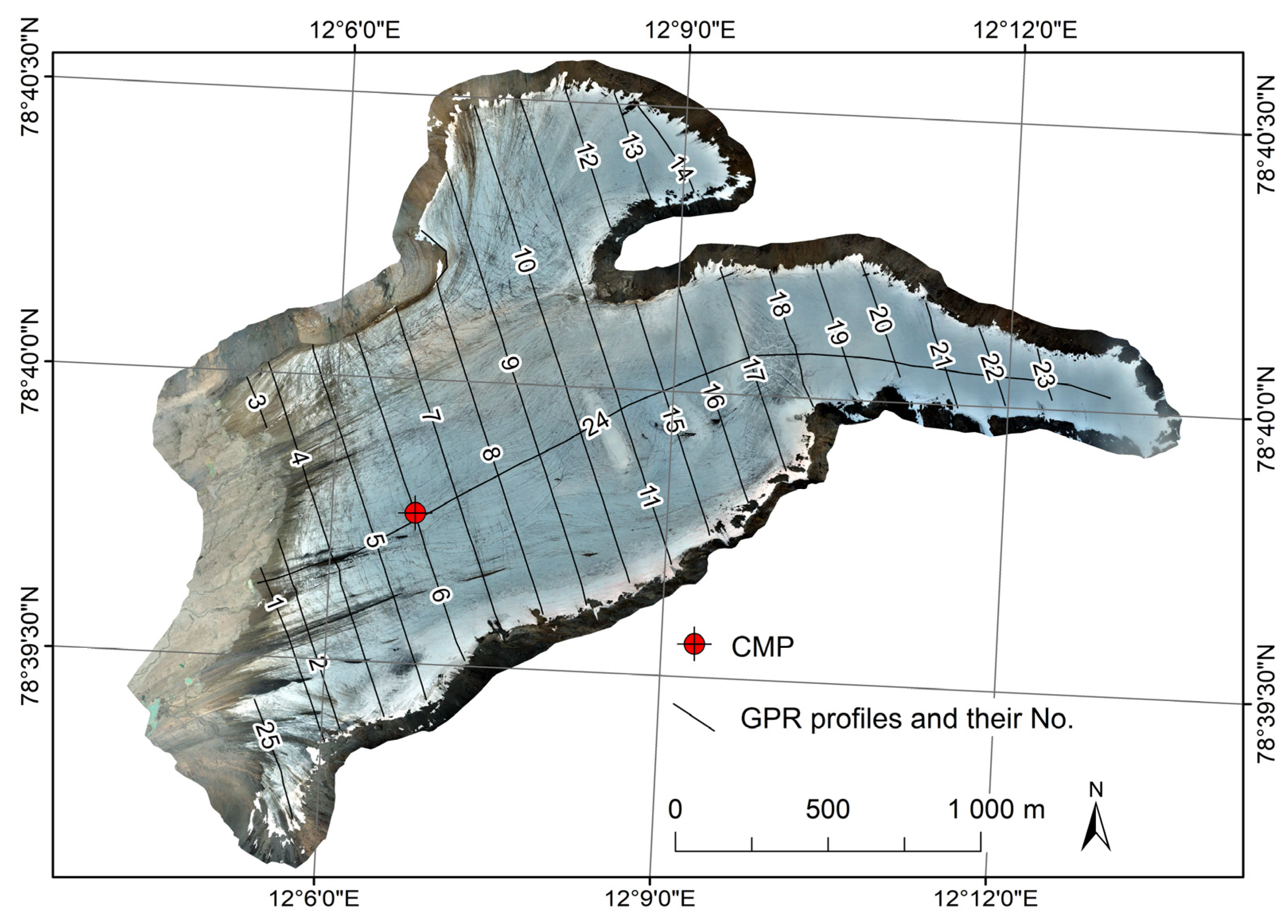
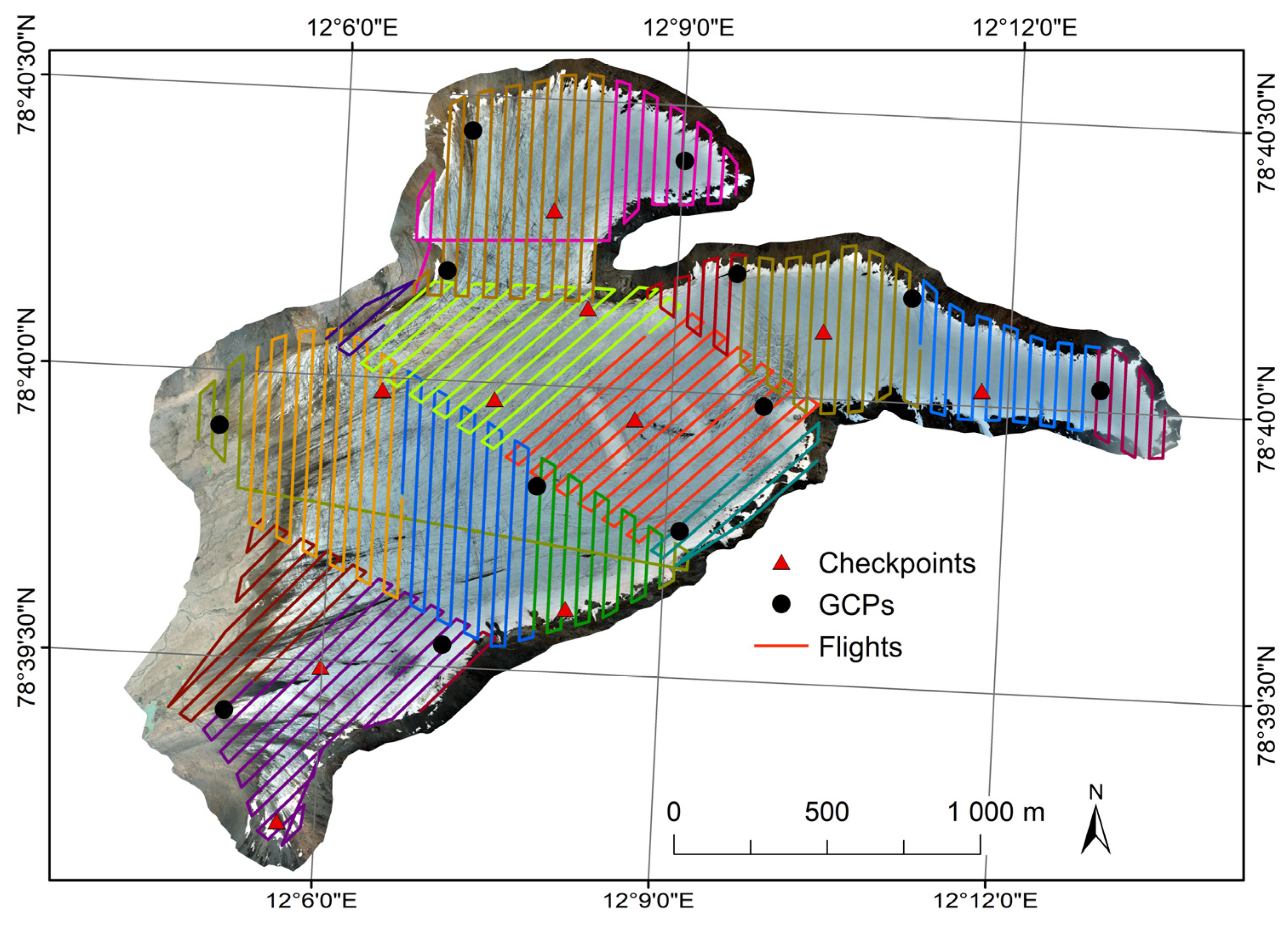



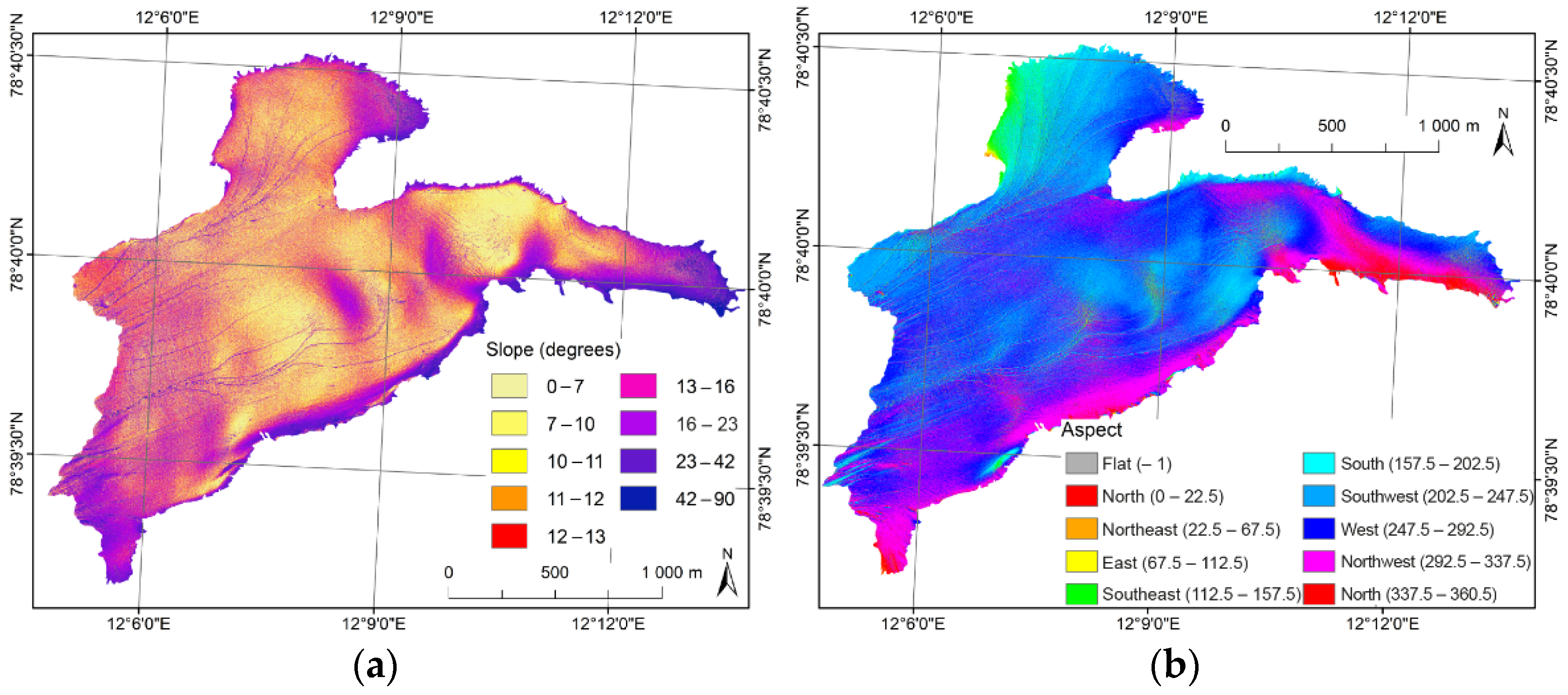
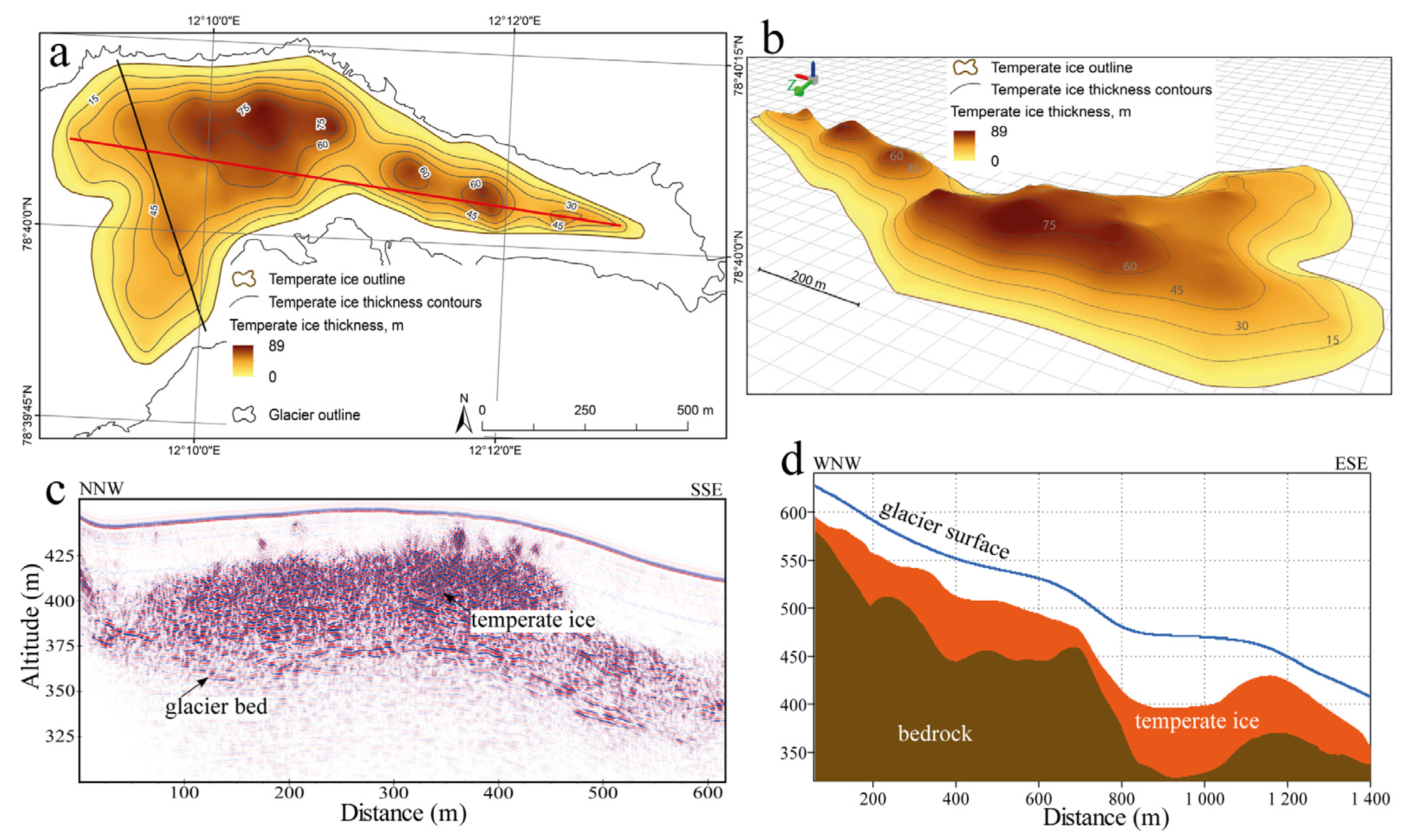

Publisher’s Note: MDPI stays neutral with regard to jurisdictional claims in published maps and institutional affiliations. |
© 2022 by the authors. Licensee MDPI, Basel, Switzerland. This article is an open access article distributed under the terms and conditions of the Creative Commons Attribution (CC BY) license (https://creativecommons.org/licenses/by/4.0/).
Share and Cite
Karušs, J.; Lamsters, K.; Ješkins, J.; Sobota, I.; Džeriņš, P. UAV and GPR Data Integration in Glacier Geometry Reconstruction: A Case Study from Irenebreen, Svalbard. Remote Sens. 2022, 14, 456. https://doi.org/10.3390/rs14030456
Karušs J, Lamsters K, Ješkins J, Sobota I, Džeriņš P. UAV and GPR Data Integration in Glacier Geometry Reconstruction: A Case Study from Irenebreen, Svalbard. Remote Sensing. 2022; 14(3):456. https://doi.org/10.3390/rs14030456
Chicago/Turabian StyleKarušs, Jānis, Kristaps Lamsters, Jurijs Ješkins, Ireneusz Sobota, and Pēteris Džeriņš. 2022. "UAV and GPR Data Integration in Glacier Geometry Reconstruction: A Case Study from Irenebreen, Svalbard" Remote Sensing 14, no. 3: 456. https://doi.org/10.3390/rs14030456





